Introduction
In the fast-paced world of software development, efficiency and productivity are paramount. The rise of AI coding assistants is transforming the landscape by leveraging advanced machine learning algorithms and natural language processing to offer developers contextually relevant code suggestions. These tools are not only speeding up the coding process but also enhancing the accuracy and collaborative capabilities of programming teams.
As studies show, teams utilizing AI tools complete tasks significantly faster, marking a pivotal shift towards more streamlined and effective software development. This article delves into how AI coding assistants work, their key features, benefits, best practices for implementation, common challenges, and the promising future they hold for the industry.
How AI Coding Assistants Work
AI programming assistants utilize advanced machine learning algorithms and natural language processing to comprehend programmer queries and generate contextually relevant code snippets. By examining extensive codebases and common programming patterns, these resources provide insightful, context-aware suggestions that streamline the coding process. According to a study, teams utilizing AI resources completed tasks approximately 30% quicker than those relying on traditional methods, underscoring the significant productivity enhancement these resources provide. Fluidly incorporated into programming settings, AI helpers provide immediate assistance, improving both productivity and programmer contentment. The growing use of AI-driven resources could result in significant efficiency improvements and cost reductions across different sectors, transforming the future of software creation.
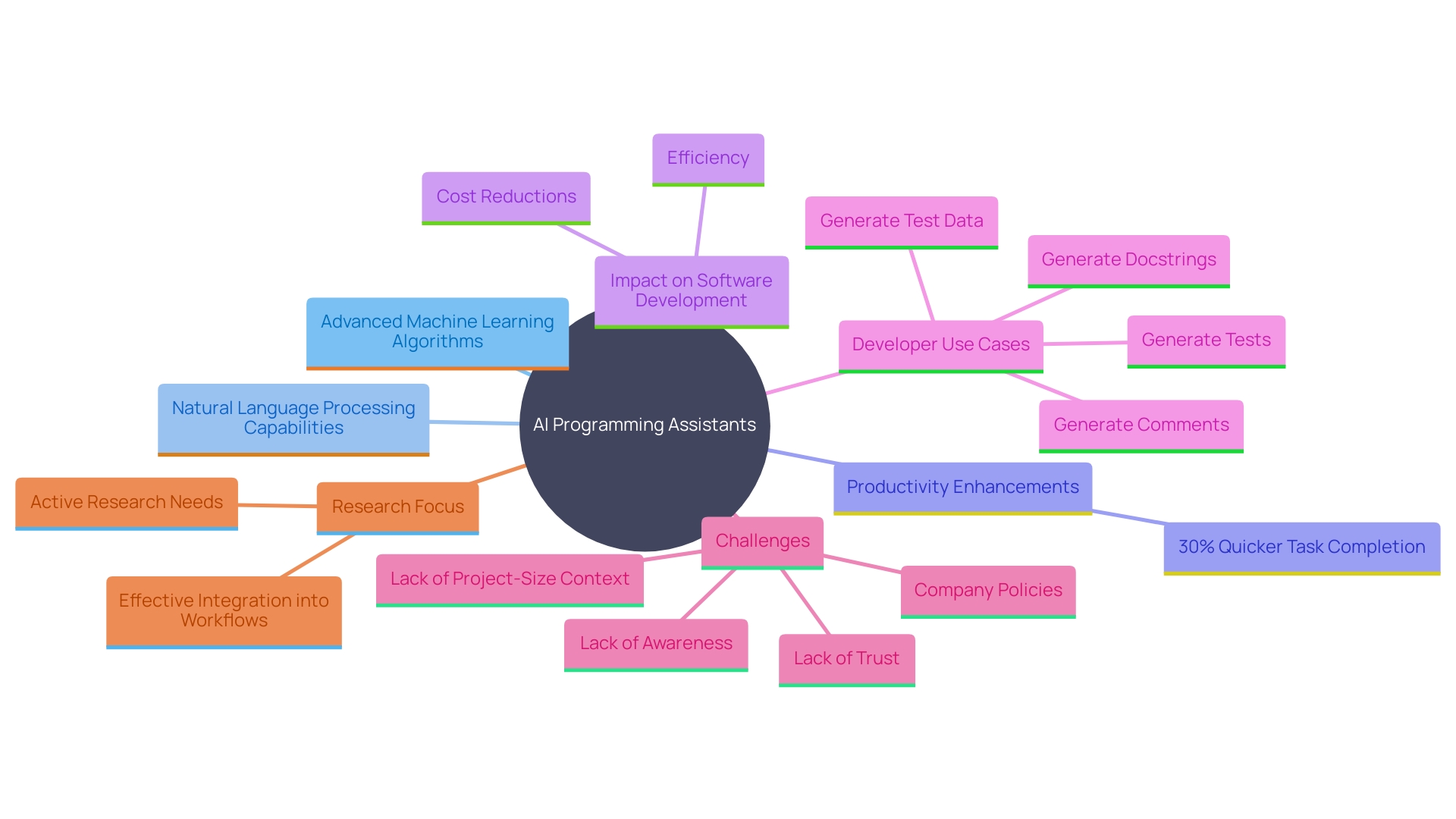
Key Features of AI Coding Assistants
AI programming tools provide a wide array of functionalities that greatly improve the output and effectiveness of software creation. These tools often include code auto-completion, which utilizes large language models (LLMs) to offer inline code suggestions, making the programming process quicker and more intuitive. Syntax highlighting helps developers identify errors and understand code structure at a glance, while error detection and debugging support streamline the troubleshooting process.
Sophisticated programming helpers enhance their functionality by incorporating machine learning to adjust to unique programming styles and preferences. This personalization ensures that the suggestions and corrections are more relevant and useful to each developer. Furthermore, many AI programming assistants offer documentation lookups and version control integration, facilitating seamless access to necessary resources and efficient project management.
Collaborative capabilities are another vital feature, enabling teams to work together more effectively. Tools like Cognition AI have demonstrated the potential of AI in aiding tasks such as bug resolution and production debugging, which are critical in enterprise settings. The effect of these instruments on productivity is clear, with quantifiable enhancements noted in different industrial settings, particularly in major companies such as Google.
The application of AI in programming has also been demonstrated to enhance the volume of code produced by AI, with studies analyzing over 150 million lines of code to evaluate the impact of tools such as Copilot. This analysis revealed a significant uptick in productivity, although it also highlighted the importance of balancing the cost of review with the added value of AI-generated suggestions.
In summary, AI programming helpers are transforming software creation by offering a range of features that improve programming speed, precision, and teamwork, supported by significant real-world effects and ongoing progress in machine learning technologies.
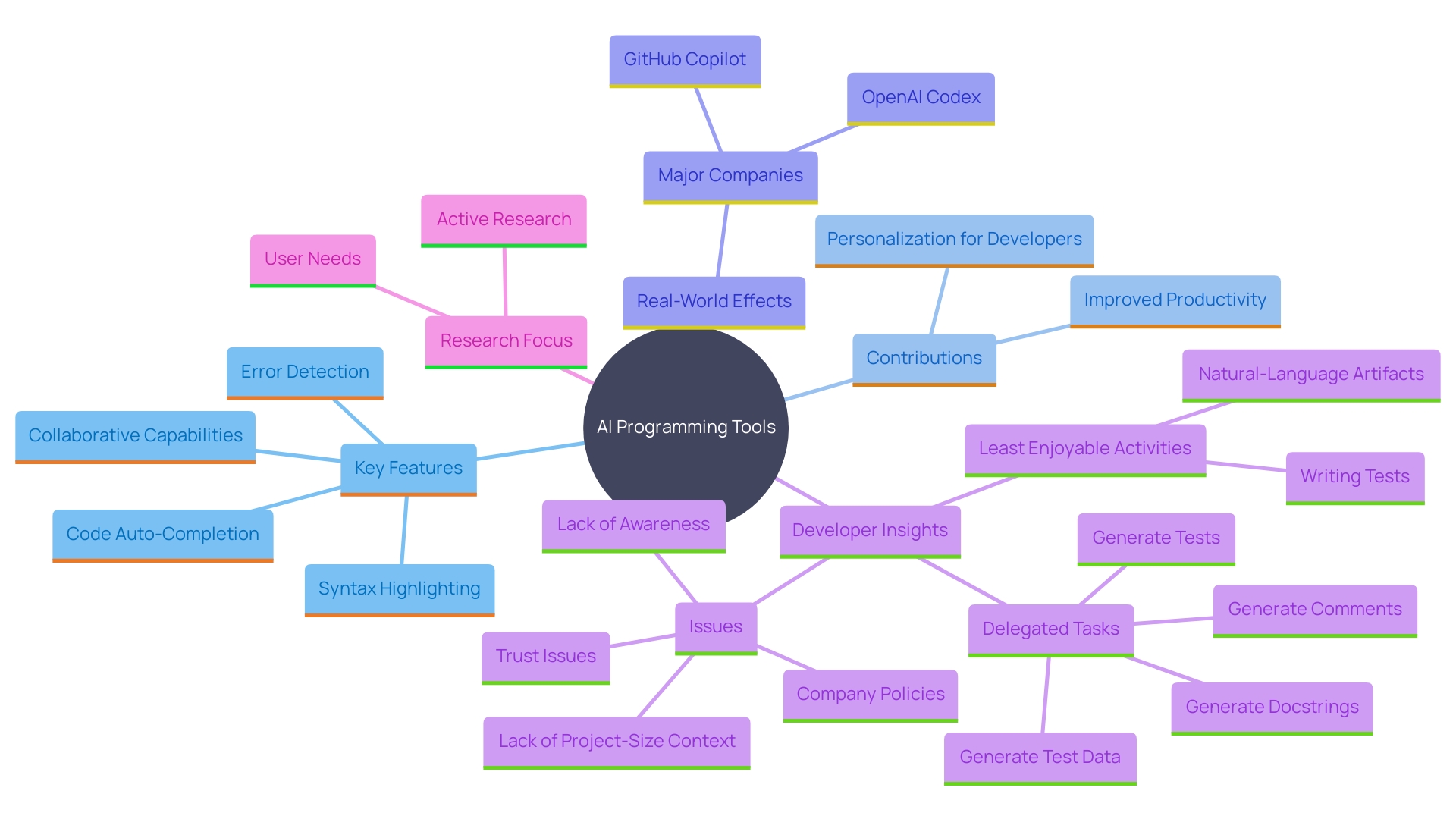
Benefits of Using AI Coding Assistants
AI coding assistants are transforming software creation by significantly decreasing time required and enhancing productivity. In a randomized controlled trial involving hundreds of software creation teams, those utilizing AI-powered resources finished their tasks approximately 30% quicker on average than those using conventional resources. This dramatic increase in speed can be attributed to the automation of repetitive tasks and minimization of errors, allowing developers to focus on complex problem-solving.
For new programmers, these resources offer immediate feedback and suggestions, fostering a more efficient learning environment. In addition, AI resources with capabilities like natural language code generation, automated testing, and intelligent code completion enhance the overall development process. As GitHub's CEO, Thomas Dohmke, emphasized, AI programming helpers contribute to maintaining workflow efficiency by keeping essential information easily accessible alongside the code being developed.
The implications of these findings indicate that companies utilizing AI resources can attain significant efficiency improvements and cost reductions, highlighting the transformative effect AI is having on the software engineering sector.
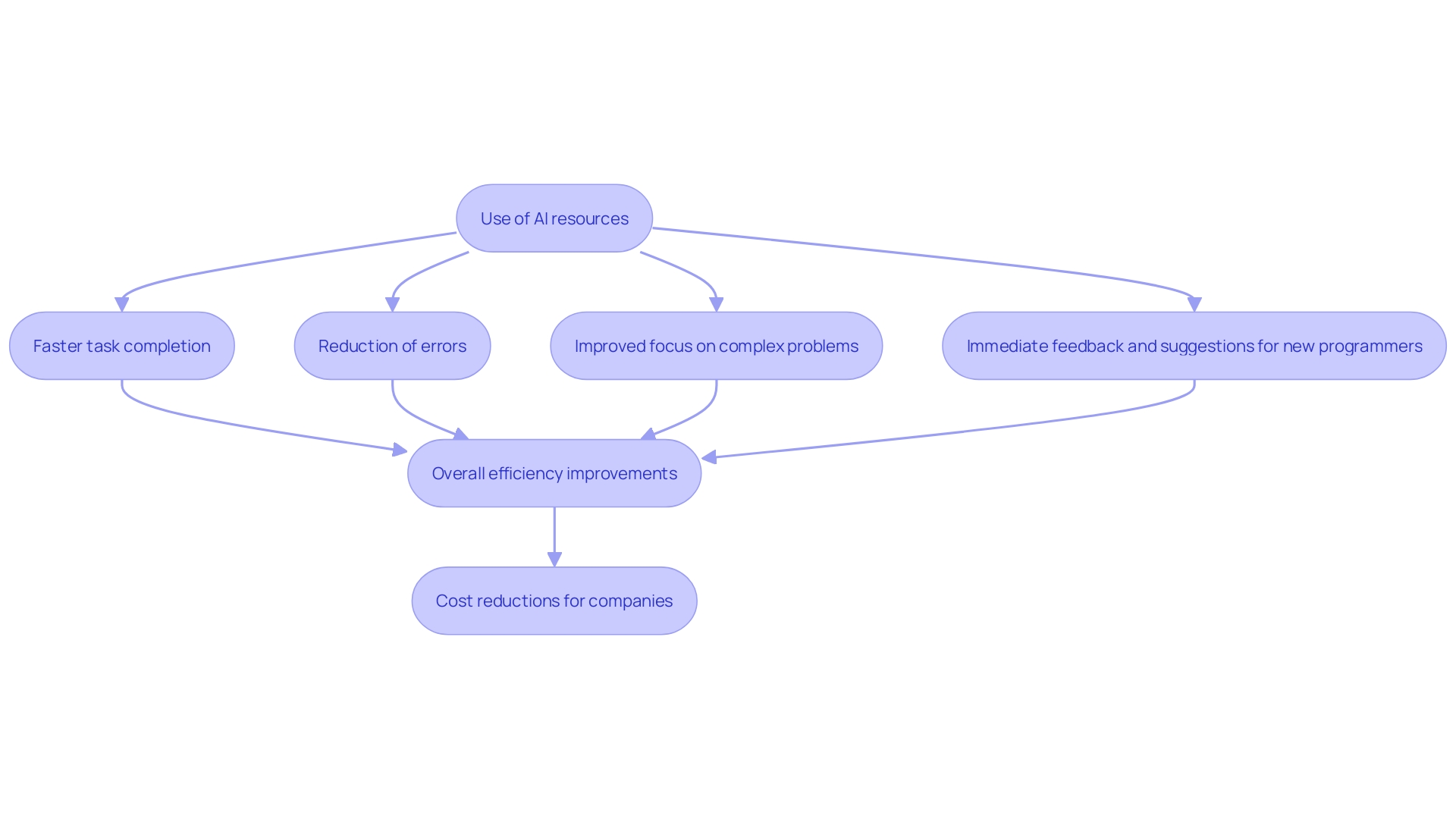
Best Practices for Implementing AI Coding Assistants
Enhancing the advantages of AI programming helpers requires selecting a resource that smoothly combines with your workflow and technology stack. Encouraging team members to actively use features such as code suggestions and collaborative coding can significantly enhance productivity. For example, a research project involving hundreds of software creation groups demonstrated that those utilizing AI resources finished tasks approximately 30% quicker on average compared to those employing conventional techniques. At Pinterest, the implementation of AI-assisted development resulted in notable improvements in developer efficiency, balancing safety, security, and cost. Regularly reviewing and adjusting the use of these tools based on feedback and project needs ensures they remain effective and beneficial.
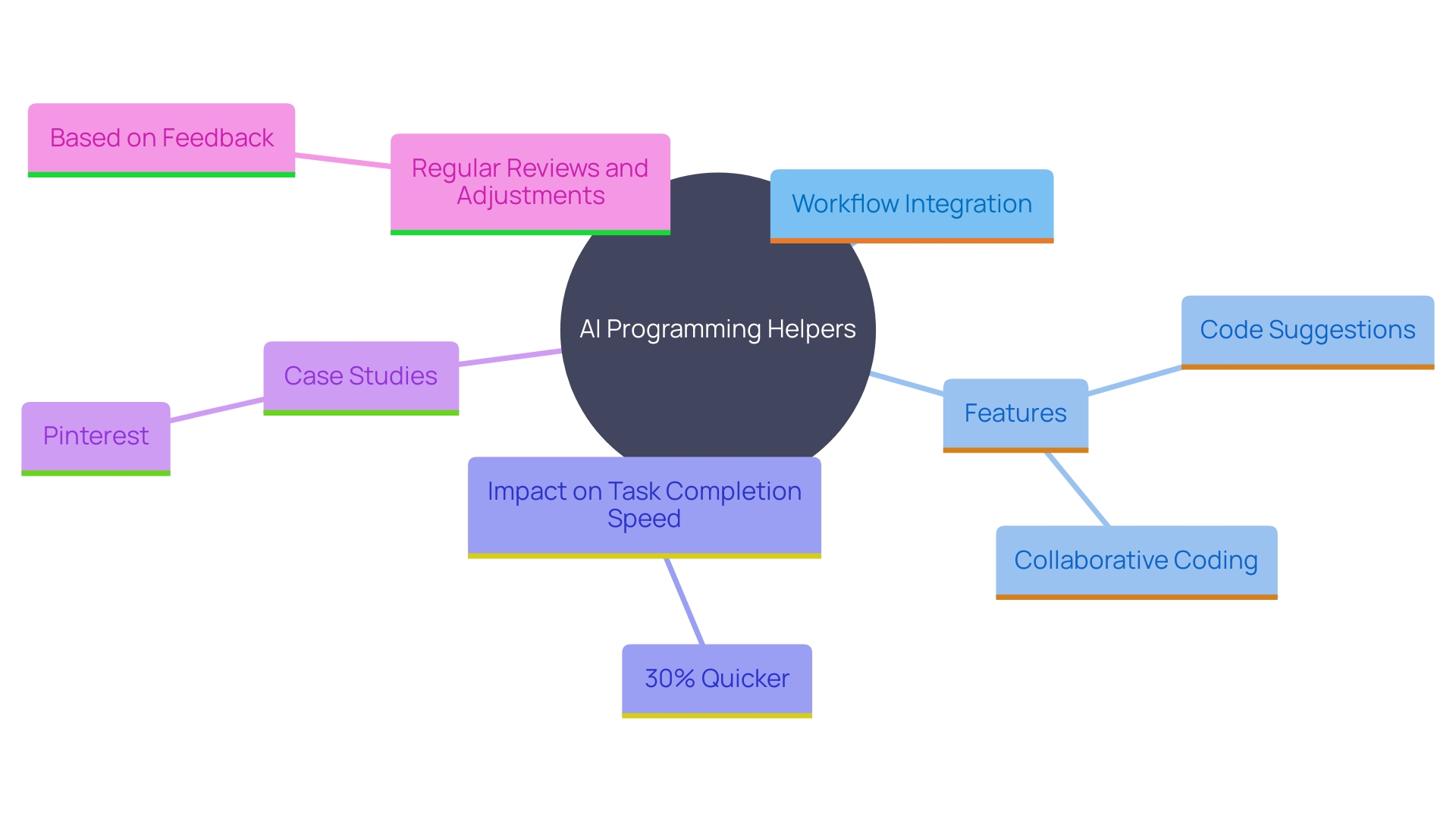
Common Challenges and Limitations
Although AI programming helpers provide many benefits, they are not free from difficulties. Developers may encounter limitations in understanding complex or niche programming tasks. A survey conducted by CodeSignal revealed that developers often find writing tests and natural-language artifacts to be the least enjoyable activities, which they prefer to delegate to AI assistants. However, over-reliance on AI-generated code can lead to a lack of deep understanding of the code being written.
Ensuring that AI-generated code adheres to security practices is another significant concern. A report emphasized that less than 10% of surveyed teams have adopted automated security inspections, and only a quarter utilize automated resources to verify the security of open-source components. This absence of automated testing is troubling, considering that 86% of developers voiced worries about the security ramifications of AI code completion software.
The swift advancement of AI programming helpers requires a greater comprehension of their application and the necessity for enhancements. Tackling these obstacles will be vital for the efficient and accountable incorporation of AI resources in software creation, improving human programming skills instead of substituting them.
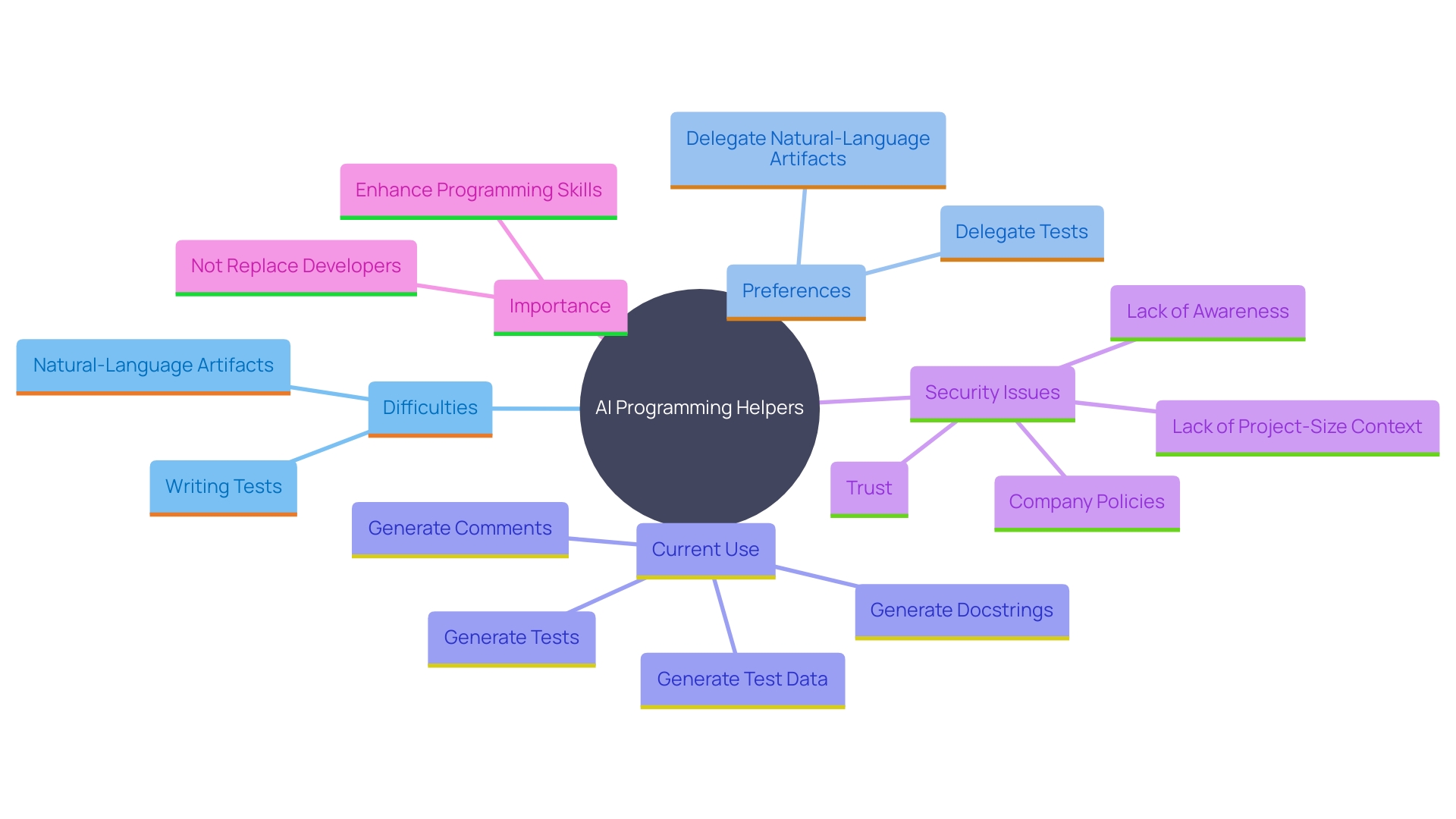
Future of AI Coding Assistants
The future of AI programming helpers is poised to transform software creation, with continuous improvements in artificial intelligence and machine learning leading the charge. AI tools have already shown their capability to greatly improve productivity; for example, a large experiment indicated that software teams utilizing AI-powered tools finished their tasks approximately 30% quicker than those employing conventional methods. This efficiency boost underscores the transformative impact AI can have, not just in speed but also in overall productivity.
As AI programming helpers advance, they will provide more tailored experiences by comprehending unique developer preferences and project contexts more effectively. This personalization is set to streamline workflows, making it easier for developers to maintain focus and flow, as highlighted by GitHub CEO Thomas Dohmke. The integration of AI into the software development lifecycle promises to fundamentally change how code is written, tested, and maintained, driving both innovation and efficiency.
Moreover, the market for AI-powered personal assistants is projected to grow substantially, from $108.60 billion in 2023 to $242.30 billion by 2030. This growth reflects the increasing importance of these tools in meeting the specific needs of developers and enhancing their capabilities. As AI continues to advance, it will play an even more integral role in software development, leading to major efficiency gains and cost savings across various industries.
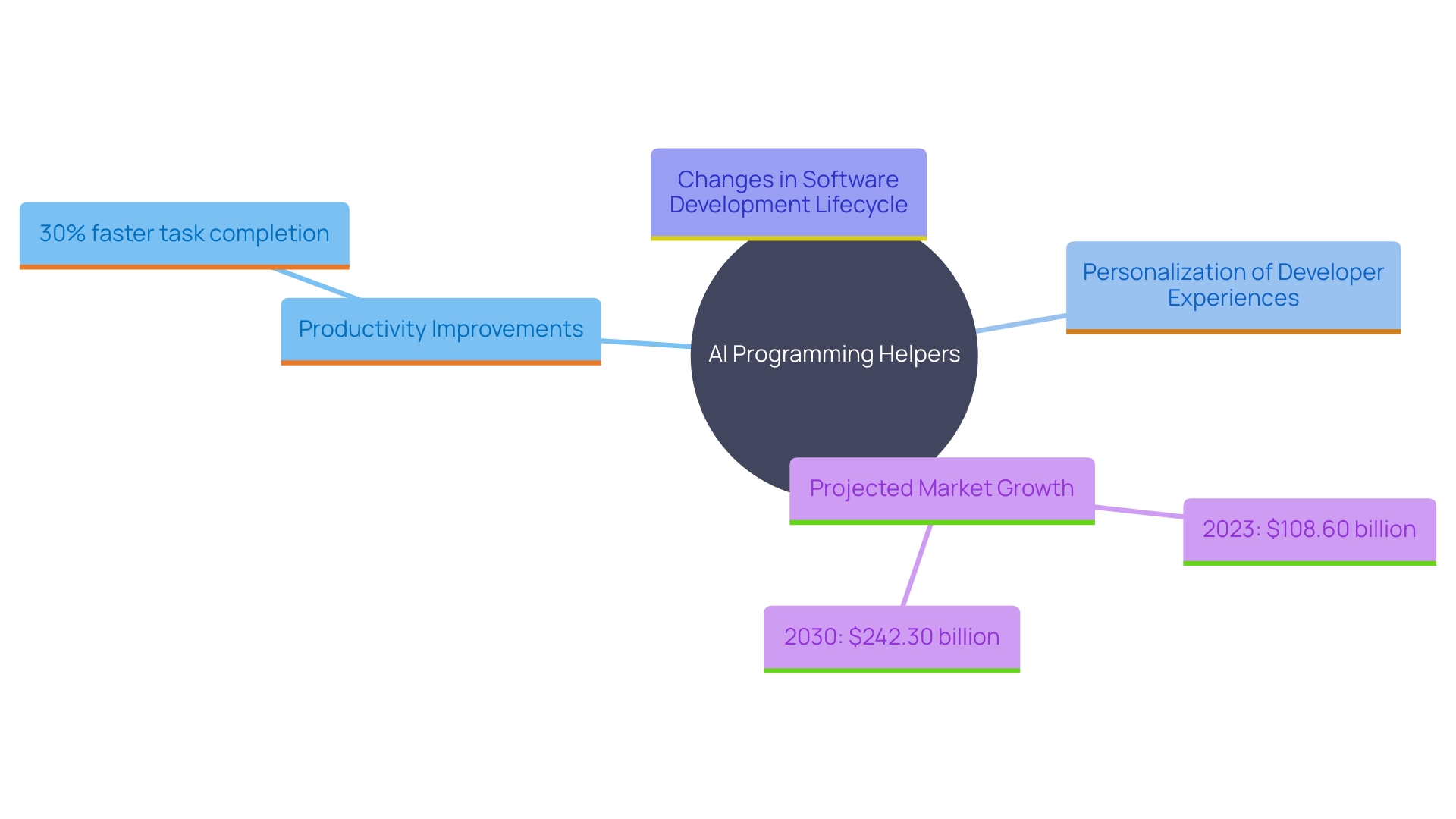
Conclusion
The integration of AI coding assistants into software development represents a transformative shift that enhances efficiency and productivity. By utilizing advanced machine learning algorithms and natural language processing, these tools provide developers with contextually relevant code suggestions, enabling them to complete tasks significantly faster. With studies showing teams achieving up to 30% faster completion rates, the impact of AI on development timelines and overall project success is undeniable.
Key features such as code auto-completion, error detection, and collaborative capabilities not only streamline the coding process but also foster a more intuitive and engaging development environment. The ability to adapt to individual coding styles ensures that developers receive tailored support, further enhancing productivity and satisfaction. As organizations increasingly adopt these tools, they are likely to experience substantial cost savings and operational efficiency.
While challenges such as over-reliance on AI and security concerns exist, the future of AI coding assistants looks promising. Ongoing advancements will likely lead to even more personalized and effective tools that cater to the evolving landscape of software development. Embracing these innovations will be crucial for companies aiming to stay competitive and maximize their development capabilities, ultimately shaping a more efficient and productive industry landscape.
Frequently Asked Questions
What are AI programming assistants?
AI programming assistants are tools that utilize advanced machine learning algorithms and natural language processing to understand programmer queries and generate relevant code snippets. They analyze extensive codebases and common programming patterns to provide context-aware suggestions.
How do AI programming assistants enhance productivity?
According to studies, teams using AI resources complete tasks approximately 30% faster than those using traditional methods. These tools automate repetitive tasks and minimize errors, allowing developers to focus on more complex problem-solving.
What functionalities do AI programming tools provide?
AI programming tools offer various features, including code auto-completion, syntax highlighting, error detection, debugging support, documentation lookups, and version control integration. These functionalities improve the efficiency and effectiveness of software creation.
How do AI coding assistants support new programmers?
AI coding assistants provide immediate feedback and suggestions, creating a more efficient learning environment for new programmers. They help enhance the overall development process by offering features like natural language code generation and automated testing.
What are the collaborative capabilities of AI programming tools?
AI programming tools facilitate better teamwork by enabling collaborative coding. They assist in tasks such as bug resolution and production debugging, making them particularly valuable in enterprise settings.
Are there any challenges associated with AI programming assistants?
Yes, developers may face limitations when dealing with complex or niche programming tasks. There is also a concern about over-reliance on AI-generated code, which can lead to a lack of deep understanding. Additionally, security practices around AI-generated code need to be prioritized, as many developers worry about security implications.
What is the future outlook for AI programming assistants?
The future of AI programming assistants looks promising, with continuous improvements in AI and machine learning expected to further enhance their capabilities. The market for AI tools is projected to grow significantly, indicating a growing reliance on these resources in software development.
How can organizations maximize the benefits of AI programming tools?
Organizations can maximize the benefits by selecting tools that integrate smoothly with existing workflows and technology stacks. Encouraging team members to utilize features such as code suggestions and collaborative coding can significantly boost productivity.
What is the impact of AI tools on the software development lifecycle?
AI programming assistants are set to fundamentally change how code is written, tested, and maintained. They promise to drive innovation and efficiency, transforming the software development landscape.
Where can I find more information about the effectiveness of AI programming assistants?
You can access studies and articles that detail the effectiveness of AI programming assistants, including their impact on productivity and task completion times, through various online platforms and research publications.




